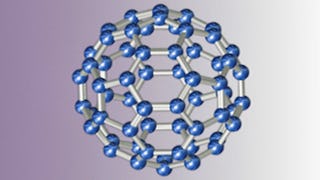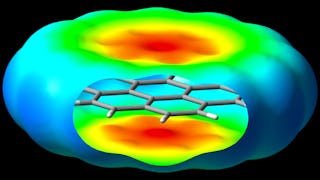This is an introductory course for students with limited background in chemistry; basic concepts such as atomic and molecular structure, solutions, phases of matter, and quantitative problem solving will be emphasized with the goal of preparing students for further study in chemistry.

Gain next-level skills with Coursera Plus for $199 (regularly $399). Save now.

Introduction to Chemistry: Structures and Solutions

Instructor: Prof. Dorian A. Canelas
69,710 already enrolled
Included with
(557 reviews)
Skills you'll gain
Details to know

Add to your LinkedIn profile
10 assignments
See how employees at top companies are mastering in-demand skills

There are 8 modules in this course
<p>Welcome! Over the eight weeks of the Introduction to Chemistry: Structures and Solutions course, we will begin discussions about the electronic structure of the atom, structures of molecules, phases of matter, and solutions. This week, we included some basic concept videos in Chemistry. These come from the partner course called Introduction to Chemistry: Reactions and Ratios. You can technically start with either course, but when these courses were originally designed, the Reactions and Ratios content came first, and you might find it helpful to complete that course before this course. If you are not familiar with the concepts of physical change v.s. chemical change, or significant figure and scientific notations, then please begin by reviewing video “Introduction”. I hope you enjoy this week's materials!</p>
What's included
8 videos1 reading
We will cover introduction to light, Bohr model of the hydrogen atom, atomic orbitals, electron configurations, valence versus core electrons. Don’t forget to use this week’s discussion forum for any questions and discussions.
What's included
7 videos1 assignment
<p>Welcome to week 2! This week we will introduce quantum numbers, more information about periodicity, chemical bonding concepts including Lewis dot structures, resonance, bond order. Continue using the discussion forum for any questions, concerns, discussions, and suggestions. We value your feedback very much!</p> <p>I hope you already found out how we captured the course logo from Colored Flames. Wasn't that fun to watch? Kudos to those of you who browsed the course, watched videos, submitted exercises, and/or posted on the discussion forum! Keep the great work going please.</p>
What's included
7 videos1 assignment
<p>Welcome to week 3! This week includes introduction to the octet rule and expanded octets, formal chargevalence shell electron pair repulsion (VSEPR) theory, sigma and pi bonds, hybridization of the main group elements, and introduction to molecular shapes.</p> <p>I hope you enjoyed the last two weeks of learning chemistry. Great work on watching videos, posting on the discussion forum and submitting your exercises!</p>
What's included
6 videos2 assignments
<p>Welcome to week 4! This week we will discuss phases of matter, the importance of thermal energy, ideal gas law calculations, kinetic molecular theory of gases. Hope you will enjoy!</p> <p>We are at the midway point in the course! As a group you have been watching videos, completing quizzes, and/or actively discussing chemistry on the forums, so please accept our compliments on your hard work so far in the course. </p>
What's included
6 videos1 assignment
<p>Welcome to week 5! This week we will examine the phases of matter more closely, looking at concepts such as intermolecular forces and thermal energy. We will also practice calculations of energetics such as those requiring enthalpies of phase transitions. Finally, we will introduce concepts in metal bonding and solid lattices. We made a few illustrative demonstrations for your viewing pleasure; I hope that these are helpful! </p><p>Remember to continue posting any questions, concerns and suggestions to the discussion forum. Also help your peers out on the forum to build a beneficial learning community together!</p>
What's included
6 videos1 assignment
<p>Welcome to week 6! We have reached the last week of video lectures and exercises for the course! Are you ready to make the final push through the rest of the material? After that, you should be ready to tackle the final exam which opens next week. I have enjoyed working on this course; and I hope you have too!</p> <p>This week, we will first release a couple of review videos related to solution and solubility from <i>Introduction to Chemistry: Reactions and Ratios</i>. Please review these important concepts before starting Lesson Two - Solutions. Then we will start with a review of dissolution and covers some concentration units. This is accompanied by solution-related demonstrations and another bonus interview with a chemist who also works at Duke. The interviews were conceived and filmed by Abdul Latif, an undergraduate in the humanities who is interested in the history of chemistry and how people choose their professions. Enjoy!</p>
What's included
11 videos2 assignments
<p>Congratulations on making through to the final week of the course! For many of you it was not an easy journey for the past six weeks with dozens of videos, exercises, problem sets, and forum discussions. I am proud of all of you! The last components of the course - final exam opens this week. Please use it as a chance to apply what you have learned from the course.</p> <p>There are two parts (timed, 90 minutes for each part) in the final exam. You are encouraged to review all course lectures, exercises, and problem sets before attempting the Final exam. Please feel welcome to use a calculator, scratch paper, simple periodic table, and the reference materials we provided in the course. Good luck with your final exam!</p>
What's included
1 reading2 assignments
Instructor

Offered by
Explore more from Chemistry
 Status: Preview
Status: PreviewDuke University
 Status: Free
Status: FreeRice University
 Status: Preview
Status: PreviewUniversity of Manchester
 Status: Free Trial
Status: Free TrialLecturio
Why people choose Coursera for their career




Learner reviews
557 reviews
- 5 stars
79.92%
- 4 stars
12.90%
- 3 stars
2.86%
- 2 stars
1.25%
- 1 star
3.04%
Showing 3 of 557
Reviewed on Aug 19, 2020
worthwhile course, great professor, advanced problem sets sometimes go beyond course scope
Reviewed on Sep 7, 2019
Fantastic and challenging. But to God be the glory. And its a course a scientist should take on. Love it.
Reviewed on Jun 6, 2020
It is excellent course. Mentor in this course are very helpful. Teacher is also very good with her knowledge and there is no doubt about way of teaching.
Frequently asked questions
No. Completion of a Coursera course does not earn you academic credit from Duke; therefore, Duke is not able to provide you with a university transcript. However, your electronic Certificate will be added to your Accomplishments page - from there, you can print your Certificate or add it to your LinkedIn profile.
To access the course materials, assignments and to earn a Certificate, you will need to purchase the Certificate experience when you enroll in a course. You can try a Free Trial instead, or apply for Financial Aid. The course may offer 'Full Course, No Certificate' instead. This option lets you see all course materials, submit required assessments, and get a final grade. This also means that you will not be able to purchase a Certificate experience.
When you purchase a Certificate you get access to all course materials, including graded assignments. Upon completing the course, your electronic Certificate will be added to your Accomplishments page - from there, you can print your Certificate or add it to your LinkedIn profile.
More questions
Financial aid available,





